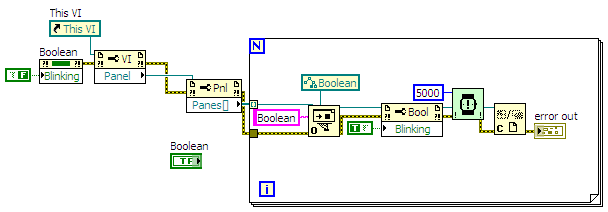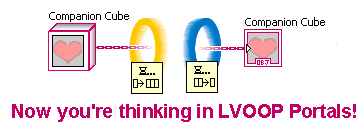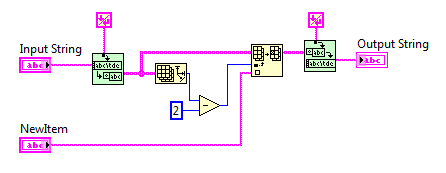-
Posts
636 -
Joined
-
Last visited
-
Days Won
3
Content Type
Profiles
Forums
Downloads
Gallery
Posts posted by TobyD
-
-
-
QUOTE(Dan Bookwalter @ Dec 28 2007, 12:12 PM)
well on windows you can hold down the ALT key then using the keypad enter the ascii code for the character you want , if remember correctly the degree is ALT-167 ....Dan
ALT+0176 will give you a smaller version. Hold either ALT key and type 0176 on the keypad (you must use the keypad - the numbers above the keyboard will not work).
ALT+167 = º
ALT+0176 = °
-
I use Outlook as my RSS feed reader and I've noticed that it is sometimes difficult to determine where the quote from a previous post ends and the reply begins. This is especially true when there are multiple quote tags with reply comments dumped throughout. Is anyone else having this problem? Is there a way to make this division a little more obvious in the RSS feeds?
-
-
QUOTE(Aristos Queue @ Sep 2 2007, 07:16 AM)
Seriously, though... it never ceases to amaze me the massive difference of opinion about these sorts of features between long-time users and new users of LabVIEW. To relatively new users, these are Heaven-sent productivity improvements, and they find going back to older versions without these to be cumbersome. Older users tend to view these with deep suspicion, even disgust that R&D spent time working on them, and generally see them as getting in the way of getting work done.I wonder if it is true of other programs to this extent? Certainly I know that autocorrection in MSWord -- which works fabulously well -- gets similar reception, old vs new.
I know this is an old thread, but I found it while searching for the "industry standard" method for using the alignment grid. Unfortunately it looks like I'll have to form my own opinion as there does not seem to be a general consensus. I generally use snap to grid with the spacing set to 8 and resize to grid turned on. I guess I'll stick with that for now.
AQ's comment reminded me of the start menu in Windows. When I switched to Vista I finally decided to give the "new" start menu style that first came out with XP a try. The first thing I always did when I sat down to a new PC was change the start menu to "classic" style (Windows 95/98) and turned off the "use personalized menus" option. After 2 months of strugling with the default menu style (I had changed my XP box at home to use the default style as well) I have now happily set everything back to "classic". I gave it a try and decided I still hate it!
That said I love the new banner menu system in Office 2007. Microsoft got it right on that one...
-
The help files for the DB Tools VIs use the older .hlp format. These files are normally opened using WinHlp32.exe, but this file does not ship with Windows Vista. Vista uses the newer .chm files. This can be resolved by manually downloading WinHlp32.exe from Microsoft (see Microsoft KB article 917607) but it would be much more convenient if the LabVIEW .hlp files could be converted.
This has been assigned CAR #4FSAA8OK by NI.
-
QUOTE(Loganxyz3129 @ Dec 26 2007, 09:33 AM)
I am an electronic and telecommunications engineering student, and I am working on a project that involves "Voice Recognition". This Voice Recognition project is about a speaker dependent, with isolated words, implementation is done in LabView 8.2, and the port to be used is a Serial or USB. please help with a example. my email is mki.par07@gmail.com thanksThere is a webcast available at http://www.ni.com/swf/flv/labview/us/vista/vr/ with a quick example of speech recog using the built in Windows Vista capabilities.
Good Luck,
Toby
-
QUOTE(BrokenArrow @ Dec 20 2007, 03:02 PM)
Check out the attached VI. Why doesn't LabVIEW find the "[". ???My slogan for this month has been "nothing is easy".
Thanks!
Richard
The left bracket is used in forming regularexpressions, so you have to use the regular expression for left bracket "\[" (or "\\[" if you are using slash codes).
-
QUOTE(tcplomp @ Dec 18 2007, 10:48 PM)
Thanks for the replies. This is the way I ended up doing it, I was just hoping there was something a little more compact. I googled the VI and found the patent that NI filed that describes it (Patent # 7159183 - Discussed under Figure 13) and it says:
QUOTE
name/order identifies the name or order, e.g. zplane order, of the object for which to obtain a reference. The name/order input may be a simple string, an array of strings, or a numeric constant. An array of names may be used if the object is a nested object. For example, to access the status boolean of an error cluster in an array called "myArray", the name array may be: ["myArray", NULL, "status"].I thought I should be able to do something with an array of names to "drill down" to the indicator ["myPane", "myBoolean"]. Unfotunately everything I tried crashed LabVIEW.
-
I'm was playing with the Open VI Object Reference function today, but I'm having trouble getting it to work in one application. My front panel is divided into 3 panes and I'm trying to access a boolean indicator in one of the panes. I'm confused about the name/order convention that the VI accepts. Using just the control name does not work. I've tried Pane#/control name and many other variations of the same. Can anyone point me in the right direction (or is there an easier way to get the job done)?
-
QUOTE( @ Dec 18 2007, 08:27 AM)
but i must to use unwire defult ,in this time my code chenge .i use this code for shift register that use in the future i cannot get true codeI don't understand what you are asking. Can you post a sample of your code with some comments that explain what you are trying to do?
-
QUOTE(Justin Goeres @ Dec 17 2007, 04:13 PM)
If you're only ever interested in replacing the last line here's one way:Note that you'll have to change the constant 0 to a 1 if your string already terminates with a CRLF (or do something slightly more elegant in general
 ).
).Side Note: I wish the Pick Line function would take negative line numbers, where e.g. -1 would give you the last line of the input string, -2 would give the second-to-last, etc.
That's creative, I like it. I was trying to come up with a way to use the Pick Line function, but all I had come up with was iterating through each line until the output was equal to the string to append (indicating you have passed the last line). It would be nice if there was a function that would return the number of lines in a multiline string or, like you mentioned, if this one would accept negative numbers.
-
QUOTE(Aristos Queue @ Dec 17 2007, 02:04 PM)
I was inspired.
If you haven't yet played Portal, I STRONGLY recommend it as the greatest video game *ever*. The freely available "Narbacular Drop" will give you some taste of the game, but only the tiniest taste. The college design team that did Narbacular was hired to do the professional version Portal. They have achieved the status of "living legends" in the game industry.
I'll admit it. That is much more fun (and creative) than dropping balls on a scale (although both can waste a surprising amount of time). I haven't played Portal yet (I'll have to hold out until Christmas to see if Santa brings me the orange box), but Narbacular Drop is a neat game. It really makes you think in 3D.
-
-
I am using a multiline string indicator to display test information as it happens. I occasionally need to overwrite the last line of the indicator. For example one test runs 50 times, so I display:
Executing test XXX - Run 01 of 50
I then overwrite that line with:
Executing test XXX - Run 02 of 50
etc.
For now, I use the OpenG VIs to convert my string to a 1D array, overwrite the last element, and then convert it back into a string. I have attached my current method, but I'm thinking that there could be a more efficient way...any ideas?
Thanks,
Toby
-
QUOTE(Norm Kirchner @ Dec 15 2007, 10:31 AM)
http://www.ewiz.com/images/rebate/62%20-%20Zonet%20MIR%2012-10%20to%2012-21.pdf' target="_blank">Zonet MIR :ninja:
-
QUOTE(silver @ Dec 12 2007, 09:40 PM)
Dear Friends,My code is so far working, but I have the following task to accomplish.
I am converting hexadecimals to Decimals (x,yz) values and plot them. The sampling rate(0,1 = 10 values per second) and the offset of the chart are given through the property node of the Chart.
I also convert the time stamp to Excel format ( e.g 36000,5 = 36000 days after the date 01.01.1900 and after the comma is the time 0,5 = 12:00:00 AM)
So now , I want to save the values in an Excel sheet with its time stamp.
How can I solve this problem?
pls see my code to get my points.
You're almost there. You can use the Write to Spreadsheet File.vi in the File I/O pallete to write your data to a .csv file. Check the help file and examples to see how this vi works.
-
-
QUOTE(Aristos Queue @ Dec 11 2007, 11:39 AM)
I found it fairly boring. Does it ever get more interesting than just putting weights on the scales? Click-hold-to-size-release --- if we slowed down the growth of the ball, the game would be trivial. The challenge of visually guaging the size of the ball and releasing at a particular time isn't exciting, to me anyway.Michael, what makes this particular game worth posting instead of the many other physics model games?
Clearly you just don't understand what constitutes a good time. It's not about the challenge, it's about the mindless waste of time and the feeling of triumph as you achieve a perfect equilibrium with your balls.

-
That's pretty good fun, but I probably should wait until I get home to play more so I don't get fired :thumbup:
-
QUOTE(Tomi Maila @ Dec 10 2007, 12:22 PM)
You don't need to place all VIs within the executable but you can also add VIs outside the executable into one or more support folder. If this is not a problems for you, then you can add your VIs you need to list into a support folder and list the content of that folder.That worked great. Thanks for the suggestion :thumbup: .
-
I want to make a splash screen that shows a progress bar as all the VIs in my program load. I can do this easily during development by using the List Directory VI to get an array of VI names and then use a for loop to create a reference to each one (thus loading it into memory). I use the iteration terminal of the for loop to drive the progress bar and I can display the VI name if I want to. See attachment.
My problem is how to make this work once the application is built. Is there a way to extract the VI names from the EXE in LV8.5?
-
QUOTE(Stevio @ Dec 10 2007, 07:19 AM)
Hellow,I need to design software for a medical application as a schoolproject. I have already a classic 1D array that is been visualized in a graph. (see attachement) How can i calculate the frequency of this signal? Another parameter i want to know is the risetime of every pulse...
When i visualized the derivate of this signal i see a lot of noise in it. I guess this is because i have an array and not a real signal. Is it possible to smooth graphs? I never used filtering before.
Thanks in advance
Greetings
There is an entire set of signal processing VIs that should do everything you need. I think they are part of the DSP toolkit.
-
QUOTE(Jon Sweeney @ Dec 7 2007, 12:11 PM)
I recently became unemployed and decided to have some fun with LabVIEW in my spare time, because it has given me much fun in the past. The attached vi is an idea for a multipurpose front panel (pattern). This one is proportioned such that two could be stacked on a screen.Don't know if there are other front panel patterns (fpp's) available but it seems like a interesting topic to me.
best regards,
Jon
Perhaps I'm missing something, but I'm not sure what this would be used for. Please fill me in.







Using a new sub vi
in Application Design & Architecture
Posted
QUOTE(Norm Kirchner @ Jan 2 2008, 11:37 AM)
Looks like a cool program. The site says it will eventualy become something else...any idea what? I'll have to play with it some more to decide if it's worth keeping.